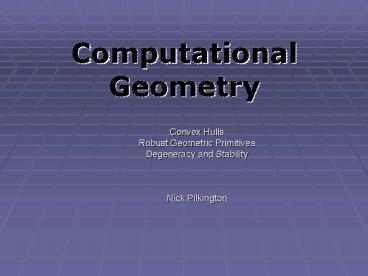Computational Geometry - PowerPoint PPT Presentation
1 / 18
Title:
Computational Geometry
Description:
Pick a point that you know to be on the convex hull. ... Heron's Formula. Area = Sqrt(s(s-a)(s-b)(s-c)), where s = (a b c)/2. Determinant / Cross Product ... – PowerPoint PPT presentation
Number of Views:149
Avg rating:3.0/5.0
Title: Computational Geometry
1
Computational Geometry
- Convex Hulls
- Robust Geometric Primitives
- Degeneracy and Stability
- Nick Pilkington
2
Convex Hull
3
Convex Hull
4
Identifying
- Two points furthest distance from each other.
- Minimum set of points enclosing
- Ideas of fencing, encompassing or enclosing
- Diameter, furthest pair, longest distance between
5
Algorithms
- Jarvis March
- O(n.h)
- Graham Scan
- O(n.log n)
6
Jarvis March
- Pick a point that you know to be on the convex
hull. - To determine the next point on the hull, loop
through all points and find the one that forms
the minimum sized anticlockwise angle off the
horizontal axis from the previous point. - Continue until you encounter the first point
7
Pros and Cons
- Pros
- Easy to program
- Cons
- Slow! Possibly O(n2)
8
Graham Scan
- Find a point you know to be on the convex hull.
(Lower y coordinate) - Sort all other points angularly around this point
(anti clockwise), by calculating the angle that
each point makes with the x axis (within the
range 0 to 360 degrees) - Add the first two points to the hull.
- For every other point except the last point
- Make it the next point in the convex hull
- Check to see if the angle it forms with the
previous two points is greater than 180 degrees - As long as the angle formed with the last two
points is greater than 180 degrees, remove the
previous point - To add the last point
- Perform the deletion above,
- Check to see if the angle the last point forms
with the previous point and the first point is
greater than 180 degrees or if the angle formed
with the last point and the first two points is
greater than 180 degrees. - If the first case is true, remove the last point,
and continue checking with the next-to-last
point. - If the second case is true, remove the first
point and continue checking. - Stop when neither case is true.
9
Graham Scan
8
6
9
10
7
4
11
3
5
2
1
10
Pros and Cons
- Pros
- Fast
- Relatively Easy to Program
- Cons
- Bit fiddly to program
11
Robust Geometric Primitives
- Area of a Triangle
- Line / Line Segment Intersection
- Point in Polygon
- Area of a Polygon
- Pitfalls, Arithmetic Accuracies, Exceptions.
12
Area of a Triangle
- Herons Formula
- Area Sqrt(s(s-a)(s-b)(s-c)), where s
(abc)/2 - Determinant / Cross Product
13
Line/Line Segment
- Line / Line Segment
- Above and Below Test
- Use the signed area of the triangle
- Line Segment / Line Segment
- Same a s above, however TWO checks are necessary!
14
Point in Polygon
- Extend the point in a random direction forming a
ray. - Find the number of times the ray intersects an
edge of the polygon. - Even number of intersections outside
- Odd number of intersection inside
Algorithm generalizes to 3 dimensions!
15
Area of Polygon
Area of polygon The area of a polygon with
vertices (x 1, y 1), ..., (x n, y n) is equal to
the determinant 1 x1 x2 . . . xn
--- 2 y1 y2 .
. . yn This formula generalizes to compute d!
times the volume of a simplex in d
dimensions. Areas and volumes are signed!
16
Area of a Polygon
- Triangulation
- Monte Carlo Methods
17
Pitfalls
- Degeneracy
- Ignore It !
- Deal with It!
- Numerical Stability
- Precision!
- Rounding Errors!
18
Questions
- IOI 2003 Day 2 Boundary
- Given a rectangular field with fence posts 1
meter apart along its perimeter. An number of
rocks represented by polygons in the field. A
viewers position. Calculate the number of fence
posts that a person at the viewers position can
see, unobstructed by rocks in the field. - O(N.R) 7280
- O(R log R N Log d) 100
- Looking at the top 20 places from IOI 2003
only 6 of them scored more than 72 in this
problem.































